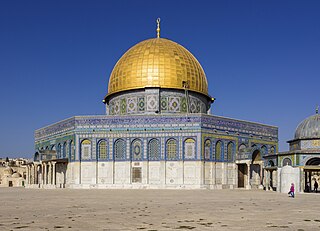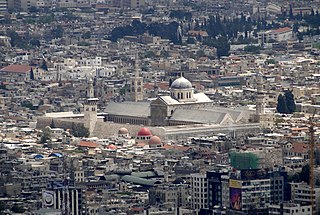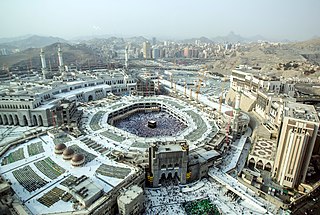Related Research Articles

The Druze, who call themselves al-Muwaḥḥidūn, are an Arab esoteric religious group from West Asia who adhere to the Druze faith, an Abrahamic, monotheistic, and syncretic religion whose main tenets assert the unity of God, reincarnation, and the eternity of the soul.
A mosque, also called a masjid, is a place of worship for Muslims. The term usually refers to a covered building, but can be any place where Islamic prayers are performed, such as an outdoor courtyard.

The Dome of the Rock is an Islamic shrine at the center of the Al-Aqsa mosque compound on the Temple Mount in the Old City of Jerusalem. It is the world's oldest surviving work of Islamic architecture, the earliest archaeologically attested religious structure to be built by a Muslim ruler and its inscriptions contain the earliest epigraphic proclamations of Islam and of the Islamic prophet Muhammad.

The terms Muslim world and Islamic world commonly refer to the Islamic community, which is also known as the Ummah. This consists of all those who adhere to the religious beliefs, politics, and laws of Islam or to societies in which Islam is practiced. In a modern geopolitical sense, these terms refer to countries in which Islam is widespread, although there are no agreed criteria for inclusion. The term Muslim-majority countries is an alternative often used for the latter sense.

Madrasa, sometimes transliterated as madrasah or madrassa, is the Arabic word for any type of educational institution, secular or religious, whether for elementary education or higher learning. In countries outside the Arab world, the word usually refers to a specific type of religious school or college for the study of the religion of Islam, though this may not be the only subject studied.

A minaret is a type of tower typically built into or adjacent to mosques. Minarets are generally used to project the Muslim call to prayer (adhan) from a muezzin, but they also served as landmarks and symbols of Islam's presence. They can have a variety of forms, from thick, squat towers to soaring, pencil-thin spires.

Islamic architecture comprises the architectural styles of buildings associated with Islam. It encompasses both secular and religious styles from the early history of Islam to the present day. The Islamic world encompasses a wide geographic area historically ranging from western Africa and Europe to eastern Asia. Certain commonalities are shared by Islamic architectural styles across all these regions, but over time different regions developed their own styles according to local materials and techniques, local dynasties and patrons, different regional centers of artistic production, and sometimes different religious affiliations.

Mihrab is a niche in the wall of a mosque that indicates the qibla, the direction of the Kaaba in Mecca towards which Muslims should face when praying. The wall in which a mihrab appears is thus the "qibla wall".

The Khalwati order is an Islamic Sufi brotherhood (tariqa). Along with the Naqshbandi, Qadiri, and Shadhili orders, it is among the most famous Sufi orders. The order takes its name from the Arabic word khalwa, meaning “method of withdrawal or isolation from the world for mystical purposes.”

The Umayyad Mosque, also known as the Great Mosque of Damascus, located in the old city of Damascus, the capital of Syria, is one of the largest and oldest mosques in the world. Its religious importance stems from the eschatological reports concerning the mosque, and historic events associated with it. Christian and Muslim tradition alike consider it the burial place of John the Baptist's head, a tradition originating in the 6th century. Two shrines inside the premises commemorate the Islamic prophet Muhammad's grandson Husayn ibn Ali, whose martyrdom is frequently compared to that of John the Baptist and Jesus.

A congregational mosque or Friday mosque, or sometimes great mosque or grand mosque, is a mosque for hosting the Friday noon prayers known as jumu'ah. It can also host the Eid prayers in situations when there is no musalla or eidgah available nearby to host the prayers. In early Islamic history, the number of congregational mosques in one city was strictly limited. As cities and populations grew over time, it became more common for many mosques to host Friday prayers in the same area.
Khalwa has several meanings in Sufism, Islamic jurisprudence, and the Druze religion, which in some way derive from the concept of being alone or withdrawing from the world.

Moorish architecture is a style within Islamic architecture which developed in the western Islamic world, including al-Andalus and what is now Morocco, Algeria, and Tunisia. Scholarly references on Islamic architecture often refer to this architectural tradition in terms such as architecture of the Islamic West or architecture of the Western Islamic lands. The use of the term "Moorish" comes from the historical Western European designation of the Muslim inhabitants of these regions as "Moors". Some references on Islamic art and architecture consider this term to be outdated or contested.

The Dolmabahçe Mosque is a baroque waterside mosque in Kabataş in the Beyoğlu district of Istanbul, Turkey, close to the Dolmabahçe Palace. It was commissioned by Queen Mother Bezmialem Valide Sultan and designed by the Turkish Armenian architect, Garabet Balyan in 1855. After his mother's death, Sultan Abdülmecid saw the building work through to completion.

The Nebi Akasha Mosque, also Okasha mosque or Ukasha mosque, is an historic mosque and maqam on Straus Street in western Jerusalem, north of the Old City.

Ottoman architecture in Egypt, during the period after the Ottoman conquest in 1517, continued the traditions of earlier Mamluk architecture but was influenced by the architecture of the Ottoman Empire. Important new features introduced into local architecture included the pencil-style Ottoman minaret, central-domed mosques, new tile decoration and other characteristics of Ottoman architecture. Architectural patronage was reduced in scale compared to previous periods, as Egypt became an Ottoman province instead of the center of an empire. One of the most common types of building erected in Cairo during this period is the sabil-kuttab.

Architecture Of Saudi Arabia was not different in the pre-oil era during the early 1930s from what it was across the past centuries. Construction and building activities followed a simple and modest style back then, as there was a lack of specialized architects in the modern sense. Instead, native communities would erect their own structures manually through the efforts of builders using basic means and local materials in what came to be known as “traditional architecture.” Every region in Saudi Arabia was famous for its own brand of architecture that expressed its artistic taste. Building materials used at that time were sourced from the local environment, such as clay, rock, palm fronds, and wood. Similarly, the architectural styles passed on from generation to generation reflected each region's climatic and environmental conditions.

The architecture of Tunisia began with the ancient civilizations such as the Carthaginians, Numidians, and Romans. After the 7th century, Islamic architecture developed in the region under a succession of dynasties and empires. In the late 19th century French colonial rule introduced European architecture, and modern architecture became common in the second half of the 20th century. The southern regions of the country are also home to diverse examples of local vernacular architecture used by the Berber (Amazigh) population.

Najdi architecture is a vernacular architecture indigenous to the Najd region of modern-day Saudi Arabia. The style flourished roughly between 13th and 18th centuries and is known for its desert adaptive urban patterns with low-contour earth-structured mudbrick buildings that are characterized by elements such as triangular or rectangular openings (furjat) and battlements (shurfat) as well as peepholes projecting outward from the main facade (tarma). The presence of a central courtyard and open spaces also forms a distinct part of the architectural style.
References
- 1 2 "Khalwa". Encyclopedia of Islam (2 ed.). Brill.
- 1 2 Burgoyne, Michael Hamilton (2012). "The Development of al-Haram ai-Sharif during Ottoman Rule" (PDF). Proceedings of the International Congress on al-Quds during the Ottoman Era, Damascus, 22-25 June 2009. Research Centre for Islamic History, Art and Culture. Archived from the original (PDF) on 2022-05-25.
- ↑ Alnaim, M. M. (2023). "The Architecture of Mosque Integration of Decoration, Functionality, and Spirituality: An Overview of Najd Region Mosque Architecture". Journal of Engineering Research. doi:10.36909/jer.ICMA.20217 (inactive 2024-09-09). ISSN 2307-1877.
{{cite journal}}: CS1 maint: DOI inactive as of September 2024 (link) - ↑ Samy S. Swayd (2009). The A to Z of the Druzes. Rowman & Littlefield. p. xxxix. ISBN 978-0-8108-6836-6.